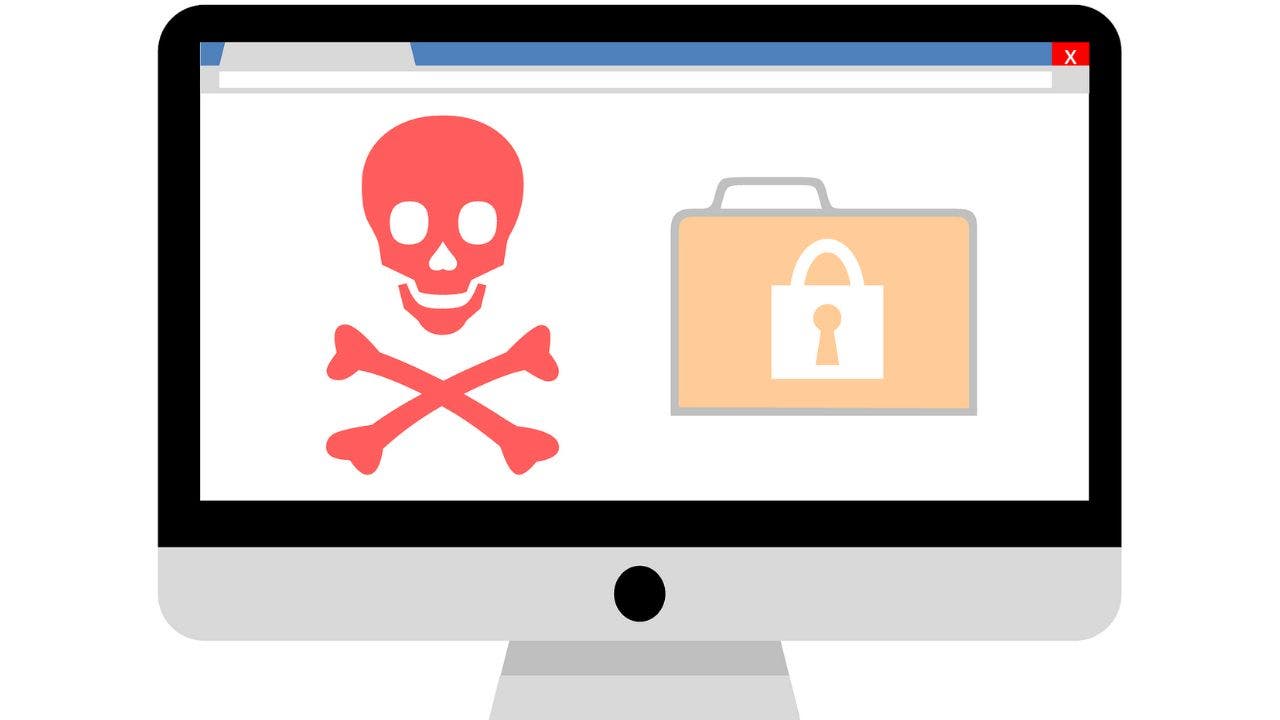If you live in Los Angeles, you are probably already intimately familiar with Watch Duty, the free app that shows active fires, mandatory evacuation zones, air quality indexes, wind direction, and a wealth of other information that everyone, from firefighters to regular people, have come to rely on during this week’s historic and devastating wildfires.
Technology
Top 7 tips for sending sensitive documents online

Gone are the days of mailing physical files or delivering them by hand to ensure the safe and secure delivery of sensitive files. While there is no guarantee or foolproof method of sharing files online, below are some of the best tips for how to share sensitive files as safely as possible.
GET SECURITY ALERTS, EXPERT TIPS – SIGN UP FOR KURT’S NEWSLETTER – THE CYBERGUY REPORT HERE
A man handing a folder to a co-worker (Kurt “CyberGuy” Knutsson)
Top 7 tips for safely sending sensitive files online
1) Restrict access to files

Red skull and bones next to protected file on a computer screen (Kurt “CyberGuy” Knutsson)
When transmitting sensitive files online, think of them as confidential documents that require stringent security protocols. Most file-sharing services offer robust access control settings, which are crucial for protecting your data. By default, shared links may allow anyone to access the file, posing a significant risk if the link is inadvertently shared with unauthorized individuals. To mitigate this, proactively adjust the settings to:
Limit access to specific individuals: Assign access rights exclusively to designated email addresses or registered users on the platform. This ensures that only verified individuals can view, edit or provide feedback on your files.
Use advanced permissions: Customize user permissions with granular control, determining who can download, edit or merely view the files. This prevents unauthorized alterations and distribution.
Enable link expiration: Set shared links to expire after a certain period or after the intended use, reducing the window of opportunity for unauthorized access.
Track file activity: Use the platform’s tracking features to monitor who accesses the files and when, providing an audit trail for security purposes.
By implementing these measures, you create a digital equivalent of a secure, locked filing cabinet, ensuring that your sensitive files remain confidential and only in the hands of those who are meant to see them.
HOW TO REMOVE YOUR PRIVATE DATA FROM THE INTERNET
2) Regularly update your software
If your system isn’t safe and protected, your files cannot stay safe and protected. By regularly updating your operating system’s software and the applications you use, you are less likely to be exposed to certain vulnerabilities. This practice is not just a recommendation; it’s a critical component of a robust cybersecurity strategy.
Software updates do more than introduce new features; they are often released to patch security holes and fix vulnerabilities that have been discovered since the last version. Cybercriminals constantly scan for systems with outdated software to exploit these weaknesses. By staying current with updates, you close these openings and make it significantly harder for attackers to gain unauthorized access to your system. Running outdated software is akin to leaving the door to your digital house unlocked. It invites a host of potential risks, including:
Malware infections: Outdated applications can become the perfect hosts for malicious software, which can spread across your network, corrupting files and stealing sensitive information.
Data breaches: Unpatched vulnerabilities can serve as entry points for data breaches, leading to the exposure of confidential data such as personal details, financial information and intellectual property.
3) Password-protect files

Username and password screen (Kurt “CyberGuy” Knutsson)
SUBSCRIBE TO KURT’S YOUTUBE CHANNEL FOR QUICK VIDEO TIPS ON HOW TO WORK ALL OF YOUR TECH DEVICES
When you can, password-protect any of the files you share online. It is an extra layer of protection that must be bypassed to access your file. Password protection requires anyone who has access to the recipient’s device to know the password to access your file, too. Consider using a password manager to generate and store complex passwords.
HOW YOUR PASSWORDS CAN BE STOLEN BY AI LISTENING TO YOUR KEYSTROKES
4) Opt for trusted file-sharing services
When it comes to transmitting sensitive data online, the integrity of your file-sharing service is paramount. Opting for established and trustworthy platforms can significantly mitigate the risk of unauthorized access or data breaches. Here are some of the most renowned and secure file-sharing services that have earned their reputation for reliability:
Microsoft OneDrive: Integrated seamlessly with Windows and Office 365, OneDrive provides a secure and efficient way to store and share files, with advanced features like Personal Vault for an extra layer of protection.
Dropbox: A pioneer in cloud storage, Dropbox has evolved to offer high-level security features, including two-factor authentication and file encryption, making it a solid choice for sensitive information.
Amazon Cloud Drive: With the backing of a tech giant, Amazon Cloud Drive delivers a secure and reliable platform for file storage and sharing, complete with comprehensive controls to manage access and permissions.
Google Drive: Renowned for its user-friendly interface, Google Drive offers robust sharing options and powerful collaboration tools, all while ensuring your data is protected with industry-leading security measures.
Each of these platforms offers unique features and security protocols. It’s essential to evaluate their offerings in relation to your specific needs. For instance, if collaboration is a key aspect of your workflow, Google Drive or Microsoft OneDrive might be more suitable due to their integration with productivity suites. On the other hand, if you’re looking for straightforward file storage with easy retrieval, Dropbox and Amazon Cloud Drive are excellent choices.
For a deeper dive into the capabilities and security features of these platforms, consider checking out “Best ways to save and restore documents,” which provides valuable insights into optimizing your file management practices while maintaining the highest security standards.
5) Install and use strong antivirus software
Before uploading or downloading any files you are sending or receiving, use your antivirus program to scan them for malware. There’s no point in securely sending or receiving corrupt files. If you don’t have one, you should, as it is also the best way to protect yourself from clicking malicious links that install malware that may access your private information. We recommend having strong antivirus protection installed on all your devices. This can also alert you of any phishing emails or ransomware scams. Get my picks for the best 2024 antivirus protection winners for your Windows, Mac, Android and iOS devices.
6) Encrypt your files

A person typing on a laptop with the words “Your personal files are encrypted” (Kurt “CyberGuy” Knutsson)
Even though emails seem almost instantaneous, the files you email can still be intercepted while traveling between you and your intended recipients. If cybercriminals intercept a file, but it is encrypted, then regardless of that breach, the file will be unreadable and useless to them. By encrypting your files, you create a formidable barrier that preserves the confidentiality and integrity of your data, ensuring that only the intended eyes can decipher the message within.
BEWARE OF ENCRYPTED PDFs AS LATEST TRICK TO DELIVER MALWARE TO YOU
7) Enable 2-factor authentication
In today’s digital world, protecting sensitive files during online transmission is crucial, and one of the most effective security measures available is two-factor authentication (2FA). This advanced security protocol requires two proofs of identity, significantly enhancing the protection of your digital assets. When you enable 2FA, you’ll first enter your username and password followed by a second form of identification, such as a code sent to your mobile device, a fingerprint or facial recognition.
The importance of 2FA cannot be overstated; it not only reduces the risk of password theft but also offers a variety of verification methods to suit your preferences, along with immediate security alerts for any unauthorized access attempts. To implement 2FA, always check the security settings of your platforms and enable it wherever possible.
For a more secure experience, consider using authenticator apps, which generate time-sensitive codes. It’s also wise to have backup codes or a secondary authentication device in case your primary 2FA method is unavailable. Incorporating 2FA into your security routine ensures that your sensitive files remain confidential and well-protected during online transactions.
Kurt’s key takeaways
While cloud and file-sharing services can make life a lot easier, it is important to protect what you are sharing, especially sensitive files. Because not all files can be password protected on every file-sharing platform or safe during online transit, the seven steps outlined above can keep your sensitive files safer when being shared online.
What additional measures do you think could enhance the security of file-sharing platforms currently available? Let us know by writing us at Cyberguy.com/Contact.
For more of my tech tips and security alerts, subscribe to my free CyberGuy Report Newsletter by heading to Cyberguy.com/Newsletter.
Ask Kurt a question or let us know what stories you’d like us to cover.
Follow Kurt on his social channels:
Answers to the most asked CyberGuy questions:
Copyright 2024 CyberGuy.com. All rights reserved.

Technology
Amazon Prime will shut down its clothing try-on program
/cdn.vox-cdn.com/uploads/chorus_asset/file/23935558/acastro_STK103__01.jpg)
Given the combination of Try Before You Buy only scaling to a limited number of items and customers increasingly using our new AI-powered features like virtual try-on, personalized size recommendations, review highlights, and improved size charts to make sure they find the right fit, we’re phasing out the Try Before You Buy option, effective January 31, 2025. Of course, customers will continue to enjoy fast, free shipping, with easy, free returns on our full apparel selection.
Technology
Fox News AI Newsletter: Tech leaders' message to Biden

Nvidia is developing real-world robots that are equipped with artificial intelligence capabilities. (Justin Sullivan/Getty Images)
Welcome to Fox News’ Artificial Intelligence newsletter with the latest AI technology advancements.
IN TODAY’S NEWSLETTER:
– Tech industry leaders urge Biden not to cement rule they say could diminish US global leadership on AI
– Sam Altman responds to lawsuit, allegations of abuse from sister
– As a Berkeley professor, I see the impact H-1B visas and AI have on students’ job opportunities
– Top tech stealing the show at CES 2025
PUSH BACK: The new rule, which industry leaders say could come as early as the end of this week, effectively seeks to shore up the U.S. economy and national security efforts by adding new restrictions on how many U.S.-made artifical intelligence products can be deployed across the globe.

Jensen Huang, co-founder and chief executive officer of Nvidia Corp., speaks during the Nvidia GPU Technology Conference (GTC) in San Jose, Calif., on Monday, March 18, 2024. (David Paul Morris/Bloomberg via Getty Images)
‘UTTERLY UNTRUE’: Open AI CEO Sam Altman on Tuesday responded to a lawsuit in which his sister accused him of sexually abusing her for nearly a decade. Altman, along with his mother and two brothers, issued a joint statement denying the claims of his sister, Ann Altman.

Sam Altman, chief executive officer of OpenAI, speaks during the Bloomberg Technology Summit in San Francisco on Thursday, June 22, 2023. (David Paul Morris/Bloomberg via Getty Images)
LOW COST LABOR: The H-1B visa program was intended to bring in specialized talent from abroad, but instead it has become a tool for employers to hire lower-cost labor for ordinary jobs.

Illustrative picture showing an application for the United States of America work visa H1B with a pen.
BEST OF CES: Get ready for some pretty cool innovations that are lighting up CES 2025, the world’s biggest annual tech event. From AI-powered smart glasses to revolutionary TVs and mind-blowing gadgets, this year’s show is proving that the future isn’t just knocking. It’s bursting through the door.

Samsung Food app. (Kurt “CyberGuy” Knutsson)
Subscribe now to get the Fox News Artificial Intelligence Newsletter in your inbox.
FOLLOW FOX NEWS ON SOCIAL MEDIA
Facebook
Instagram
YouTube
Twitter
LinkedIn
SIGN UP FOR OUR OTHER NEWSLETTERS
Fox News First
Fox News Opinion
Fox News Lifestyle
Fox News Health
DOWNLOAD OUR APPS
Fox News
Fox Business
Fox Weather
Fox Sports
Tubi
WATCH FOX NEWS ONLINE
Fox News Go
STREAM FOX NATION
Fox Nation
Stay up to date on the latest AI technology advancements and learn about the challenges and opportunities AI presents now and for the future with Fox News here.
Technology
How Watch Duty’s wildfire tracking app became a crucial lifeline for LA
/cdn.vox-cdn.com/uploads/chorus_asset/file/25824833/STKB309_WATCH_DUTY_B.jpg)
Watch Duty is unique in the tech world in that it doesn’t care about user engagement, time spent, or ad sales. The 501(c)(3) nonprofit behind it only cares about the accuracy of the information it provides and the speed with which the service can deliver that information. The app itself has taken off, rocketing to the top of Apple’s and Google’s app stores. Over 1 million people have downloaded it over the last few days alone.
The elegance of the app lies in its simplicity. It doesn’t scrape user data, show ads, require any kind of login, or track your information. Its simple tech stack and UI — most of which is maintained by volunteer engineers and reporters — has likely helped save countless lives. While Watch Duty is free to use, the app accepts tax-deductible donations and offers two tiers of membership that unlock additional features, like a firefighting flight tracker and the ability to set alerts for more than four counties.
With plans to expand the service across the United States, as well as overseas and into other emergency services, Watch Duty may eventually replace some of the slower and less reliable local government alert systems for millions of people.
Photo by Lokman Vural Elibol / Anadolu via Getty Images
An app born from fire
The idea for Watch Duty came to cofounder John Mills while he was trying to protect his off-grid Sonoma County home from the Walbridge fire in 2020. He realized there wasn’t a single source for all the information people needed to protect themselves from the blaze, which ultimately killed 33 people and destroyed 156 homes. John and his friend David Merritt, who is Watch Duty’s cofounder and CTO, decided to build an app to help.
“This came out of an idea that John had, and he talked to me about it four years ago,” Merritt tells The Verge. “We built the app in 60 days, and it was run completely by volunteers, no full-time staff. It was a side project for a lot of engineers, so the aim was to keep it as simple as possible.”
Fire reporting is piecemeal at best in fire-prone areas and frequently scattered across platforms like Facebook and X, where fire departments and counties have verified pages sharing relevant updates. But increasingly, social media platforms are putting automated access for alert services behind paywalls. Governments also use a wide variety of alert systems, causing delays that can cost lives, especially in fast-moving fires like the Palisades and Eaton fires that have forced evacuations for more than 180,000 people. And sometimes, these government-run alerts are sent out mistakenly, causing mass confusion.
Watch Duty simplifies all that for millions of people.
“We view what we are doing as a public service,” says Merritt. “It is a utility that everyone should have, which is timely, relevant information for their safety during emergencies. Right now, it’s very scattered. Even the agencies themselves, which have the best intentions, their hands are tied by bureaucracy or contracts. We partner with government sources with a focus on firefighting.”
“We view what we are doing as a public service.”
One of the biggest issues around fires, in particular, is that they can move quickly and consume large swaths of land and structures in minutes. For example, the winds that drove the Palisades fire to spread to more than 10,000 acres reached 90 miles per hour on Tuesday. When minutes matter, the piecemeal alert system that Watch Duty replaces can cause delays that cost lives.
“Some of the delivery systems for push notifications and text messages that government agencies use had a 15-minute delay, which is not good for fire,” says Merritt. “We shoot to have push notifications out in under a minute. Right now, 1.5 million people in LA are getting push notifications through the app. That’s a lot of messages to send out in 60 seconds. In general, people are getting it pretty much all at the same time.”
A simple tech stack
For Watch Duty, this kind of mass communication requires reliable technology as well as a group of dedicated staff and skilled volunteers. Merritt says that Watch Duty relies on a number of corporate partners with whom it has relationships and contracts to provide its service.
“We shoot to have push notifications out in under a minute.”
The app is built on a mix of technology, including Google’s cloud platform, Amazon Web Services, Firebase, Fastly, and Heroku. Merritt says the app uses some AI, but only for internal routing of alerts and emails. Reporters at Watch Duty — those who listen to scanners and update the app with push notifications about everything from air drops to evacuation updates — are mostly volunteers who coordinate coverage via Slack.
“All information is vetted for quality over quantity,” he says. “We have a code of conduct for reporters. For example, we never report on injuries or give specific addresses. It’s all tailored with a specific set of criteria. We don’t editorialize. We report on what we have heard on the scanners.”
According to Merritt, the app has 100 percent uptime. Even though it started with volunteer engineers, the nonprofit has slowly added more full-time people. “We still have volunteers helping us, but it’s becoming more on the internal paid staff as we grow, as things get more complex, and as we have more rigorous processes,” he says.
“All information is vetted for quality over quantity.”
He says there are no plans to ever charge for the app or scrape user data. The approach is kind of the Field of Dreams method to building a free app that saves people’s lives: if you build it well, the funding will come.
“It’s the antithesis of what a lot of tech does,” Merritt says. “We don’t want you to spend time in the app. You get information and get out. We have the option of adding more photos, but we limit those to the ones that provide different views of a fire we have been tracking. We don’t want people doom scrolling.”
Photo by FREDERIC J. BROWN / AFP via Getty Images
Collecting information in the era of Trump
Watch Duty relies heavily on publicly available information from places like the National Weather Service and the Environmental Protection Agency. Should the incoming Trump administration decide to execute on threats to dismantle and disband the EPA (which monitors air quality) and the National Oceanic and Atmospheric Administration, the parent agency to the National Weather Service, such moves would impact Watch Duty’s ability to operate.
Even still, Merritt is optimistic. “We will be pretty well insulated from any change to policy,” he says. “We are either buying that information ourselves already or we are happy to buy it, and we will take that cost on. The fact that we’re soon going to be covering the entire US will defray the cost of anything that shifts from a policy perspective. Our operation costs are mostly salaries. We are trying to hire really good engineers and have a really solid platform. If we need to raise a grant to buy data from the National Weather Service, then we will.”
Regardless of what the next administration does, it’s clear that Watch Duty has become a critical and necessary app for those in Southern California right now. The app currently covers 22 states and plans to roll out nationwide soon.
“We got 1.4 million app downloads in the last few days,” according to Merritt. “I think we have only received 60 support tickets, so that shows that something is working there. We are really just focused on the delivery of this information.”
-

 Politics1 week ago
Politics1 week agoNew Orleans attacker had 'remote detonator' for explosives in French Quarter, Biden says
-

 Politics1 week ago
Politics1 week agoCarter's judicial picks reshaped the federal bench across the country
-

 Politics1 week ago
Politics1 week agoWho Are the Recipients of the Presidential Medal of Freedom?
-

 Health6 days ago
Health6 days agoOzempic ‘microdosing’ is the new weight-loss trend: Should you try it?
-

 World1 week ago
World1 week agoSouth Korea extends Boeing 737-800 inspections as Jeju Air wreckage lifted
-
/cdn.vox-cdn.com/uploads/chorus_asset/file/25822586/STK169_ZUCKERBERG_MAGA_STKS491_CVIRGINIA_A.jpg)
/cdn.vox-cdn.com/uploads/chorus_asset/file/25822586/STK169_ZUCKERBERG_MAGA_STKS491_CVIRGINIA_A.jpg) Technology3 days ago
Technology3 days agoMeta is highlighting a splintering global approach to online speech
-

 World1 week ago
World1 week agoWeather warnings as freezing temperatures hit United Kingdom
-

 News1 week ago
News1 week agoSeeking to heal the country, Jimmy Carter pardoned men who evaded the Vietnam War draft















